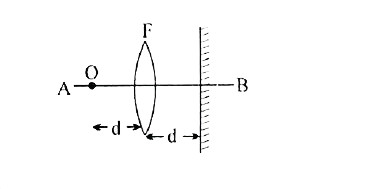A point object O moves from the principal axis of a converging lens in a direction OP. I is the image of O, will move initially in the direction

The correct Answer is:C
_E01_033_S01.png)
(i) vIx=m2v0x (same direction)
(ii) ∵ m = -ve , m=vu,
(v=-ve, u =+ve) then vIy = -ve
Topper's Solved these Questions
- GEOMETRICAL OPTICSBook:ALLENChapter:GEOMETRICAL OPTICSExercise:EXERCISE-2
Explore 44 Videos
- GEOMETRICAL OPTICSBook:ALLENChapter:GEOMETRICAL OPTICSExercise:EXERCISE-3
Explore 12 Videos
- GEOMETRICAL OPTICSBook:ALLENChapter:GEOMETRICAL OPTICSExercise:EXERCISE - 05 (B) (ASSERTION & REASON )
Explore 9 Videos
- CURRENT ELECTRICITYBook:ALLENChapter:CURRENT ELECTRICITYExercise:All Questions
Explore 427 Videos
- GRAVITATIONBook:ALLENChapter:GRAVITATIONExercise:EXERCISE 4
Explore 9 Videos
Similar Questions
A point object moves along the principal axis of a convex lens of focal length f, such that its image also formed on the principal axis at a distance 4f3 (at t=0) moves away from the lens with a uniform velocity α. Find the velocity of point source as a function of time t.
View SolutionIn the figure shown ‘O’ is point object. AB is principal axis of the converging lens of focal length F. Find the distance of the final image from the lens.

View Solution
Knowledge Check
A point object O is placed on the principal axis of a convex lens of focal length f=20cm at a distance of 40 cm to the left of it. The diameter of the lens is 10. An eye is placed 60 cm to right of the lens and a distance h below the principal axis. The maximum value of h to see the image is
A0B2.5 cmC5 cmD10 cmPoint object O is placed on the principal axis of a convex lens of focal length 20cm at a distance of 40 cm to the left of it. The diameter of the lens is 10cm to the right of the lens at a distance h below the principal axis, then the maximum value of h to see the image will be
A0B5cmC2.5cmD10cmAs an object gets closer to the focal point of a converging lens from infinity its image
Abecomes smallerBremains of the same sizeCgets farther from the lensDgets closer to the lens
An illuminated object is placed on the principal axis of a converging lens so that real image is formed on the other side of the lens. If the object is shifted a little,
View SolutionAn illuminated object is placed on the principal axis of a converging lens so the a real image is formed on the other side of the lens. If the object is shifted a little,
View SolutionAn extended object of size 2mm is placed on the principal axis of a converging lens of focal length 10cm. It is found that when the object is placed perpendicular to the principal axis the image formed is 4mm in size. The size of image when it is placed along the principal axis is ____________ mm.
View SolutionTwo point objects A and B are kept on the principal axis of a convex lens as shown. Image of both the objects is formed at same position. Find the focal length of the lens.

View SolutionA pin of length 2.0 cm lies along the principal axis of a converging lens, the centre being at a distance of 11 cm from the lens. The focal length of the lens is 6 cm. Find the size of the image.
View Solution